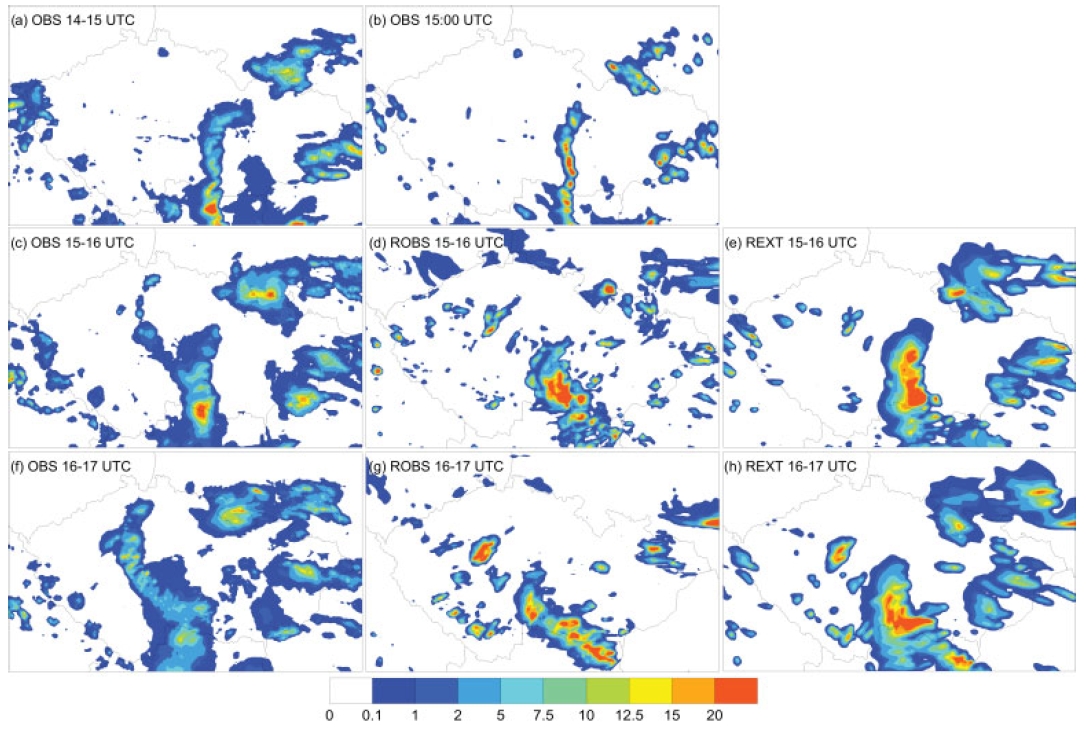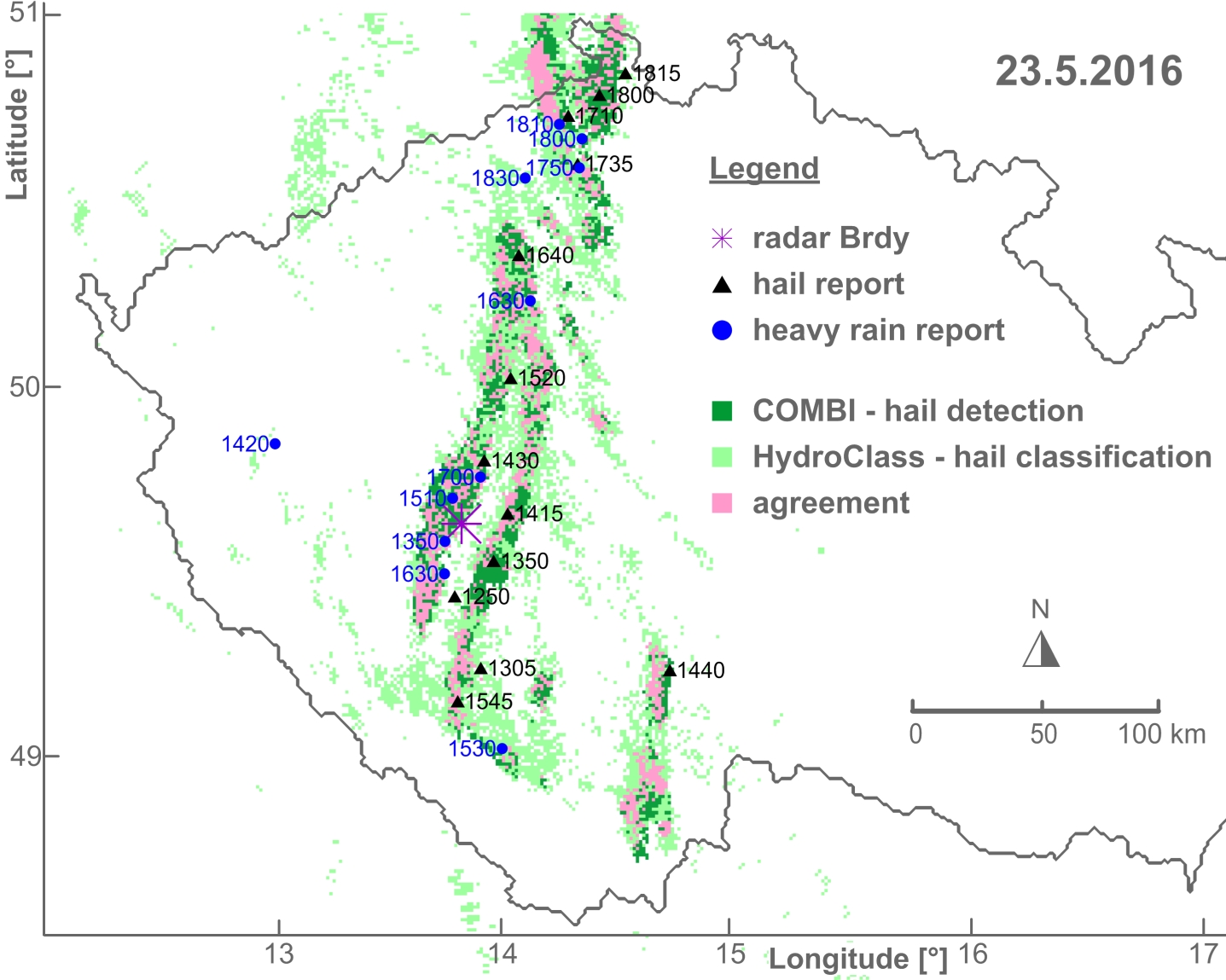
Observed (OBS) and forecasted precipitation using ROBS (assimilation of radar reflectivity) and REXT (assimilation of radar and extrapolated radar reflectivity) for July 29, 2009, 1500-1600 and 1600-1700 UTC. The assimilation window in the COSMO model ends at 1500 UTC and the free forecast begins. Panel a) shows measurements between 1400 and 1500 UTC, b) precipitation intensity at 1500 UTC, c) and f) precipitation measurement, d) and g) forecast by the ROBS method and e) and h) forecast by the REXT method.
Precipitation is one of the most interesting and the most difficult phenomena in the atmosphere to predict. Their lack and abundance significantly affect our lives. Very short-term precipitation forecast, so-called nowcasting, based on extrapolation methods, is used only for forecasts lasting from a few tens of minutes to several hours. Forecast for a longer period does not make sense, because these methods do not take into account development in the atmosphere, which significantly affects the behaviour of precipitation. The mathematical model, which is able to calculate the development of weather and thus precipitation in real time, describes the development of the atmosphere using physical equations and parameterization of processes that take place in the atmosphere. The quality of the forecast of these models, especially the precipitation forecast, depends crucially on how detailed these processes are described. The forecast accuracy also significantly depends on the input data that the model uses. There are models that describe processes in the atmosphere in detail, but these models are very time consuming and therefore are not yet used for an operational forecast.
In the research of precipitation forecast, we deal with both the improvement of very short-term precipitation forecast (nowcasting) and the inclusion of this forecast in numerical weather prediction models (Sokol a Zacharov, 2012; Pop et al 2019), or the possibility of forecasting the occurrence of clouds (Bližňák et al, 2017) . For the research of cloud-forming and precipitation-forming processes, we use the so-called one- or two-moment model microphysics (Sokol a Minářová, 2020).
The methods of forecast verification also need to be adapted to the increasing horizontal resolution of the weather forecast. A more detailed precipitation forecast brings not only higher values of forecasted precipitation, but also increases the horizontal variability of values. In summer, there are places with high and low precipitation values in a close neighbourhood. Although this corresponds to the behaviour of real precipitation, a small error in the position of forecasted precipitation leads to large errors if we compare the forecasted and measured precipitation based on values at individual points only. If we correctly forecast precipitation and shift it only, for example, 3 km east of the measured precipitation, we get a very bad result in the point-based comparison - at the point where precipitation is measured, we do not forecast anything, and vice versa, where we forecast precipitation, it does not rain. In reality, however, the forecast is very good and suitable and valuable for practical use. However, we must compromise on accuracy and interpret the forecasts appropriately. This phenomenon is the so-called double error problem. Within the research of forecast precipitation, we also deal with the research of spatial verification methods (Zacharov et al 2013), which tries to interpret precipitation forecasts appropriately.
As part of precipitation research, we also deal with the hail detection using weather radars. Techniques for hail detection from weather radar data are based on the intensity and position of the radar echo, or recognize hails from other hydrometeors using polarimetric radar quantities. The COMBI criterion combining methods for hail detection using radar data with simple polarization was developed (Skripniková a Řezáčová, 2014). We compare the results of hail detection by methods using radar data with single polarization (COMBI criterion) and with dual polarization. At the events of 2016 in the Czech Republic, the results of both approaches proved to be comparable (Skripniková a Řezáčová, 2019). Using the COMBI criterion and other detection methods, we also study the spatial distribution of hail risk in the Czech Republic (Skripniková et al. 2017). And we investigate the possibility of forecasting the occurrence of hails by a numerical weather prediction model (Sokol et al, 2016; Sokol et al. 2014).
- LTC19043 , Extremita a příčiny sdružených meteorologických událostí ve střední Evropě, 2019-2022, řešitel (ÚFA): Skripniková Kateřina
- MŠMT. LD11044 , Verifikace numerické předpovědi konvektivních srážek - hodnocení účinnosti fyzikálních parametrizací, 2011-2014,
- COST. ES0905 , Basic Concepts for Convection Parameterization in Weather Forecast and Climate Models, 2010-2014
- GA ČR. GPP209/12/P701, Odhad nejistoty předpovědi konvektivních srážek s využitím regionálního ensemblového systému, 2012-2014,
- MŠMT. ME09033 , Velmi krátkodobá srážková a hydrologická předpověď zaměřená na prognózu přívalových povodní, 2009-2012
- Sokol, Z., Minářová, J., 2020: Impact of 1- and 2-moment cloud microphysics and horizontal resolution on lightning Potential Index within COSMO NWP model, Atmospheric Research, 237, 104862
- Pop, L., Sokol, Z., Minářová, J., 2019: Nowcasting of the probability of accumulated precipitation based on the radar echo extrapolation, Atmospheric Research, 216, 1-10
- Skripniková, K., Řezáčová, D., 2019: Comparison of Radar-Based Hail Detection Using Single- and Dual-Polarization, Remote Sensing, 11, 12, 1436
- Bližňák, V., Sokol, Z., Zacharov, P., 2017: Nowcasting of deep convective clouds and heavy precipitation: Comparison study between NWP model simulation and extrapolation, Atmospheric Research, 184, 24-34
- Sokol, Z.; Bližňák, V.; Zacharov, P.; Skripniková, K., 2016: Nowcasting of hailstorms simulated by the NWP model COSMO for the area of the Czech Republic, Atmospheric Research, 171, 66-76
- Sokol, Z., Skripniková, K., Zacharov, P., jr., 2014: Simulation of the storm on 15 August, 2010, using a high resolution COSMO NWP model, Atmospheric Research, 137, 100-111
- Skripniková, K.; Řezáčová, D., 2014: Radar-based hail detection, Atmospheric Research, 144, 1, 175–185
- Zacharov, P., Řezáčová, D., Brožková, R., 2013: Evaluation of the QPF of convective flash flood rainfalls over the Czech territory in 2009, Atmospheric Research, 131, -, 95-107
- Sokol, Z., Zacharov, P., 2012: Nowcasting of precipitation by an NWP model using assimilation of extrapolated radar reflectivity, Quarterly Journal of the Royal Meteorological Society, 138, 665, 1072-1082

